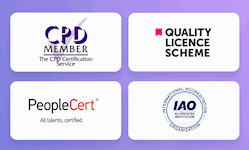AutoCAD Programming Using C#.NET
Accredited by IAO | Complete Video Lessons from Expert Instructor | Tutor Support Included
One Education
Summary
- Exam(s) / assessment(s) is included in price
- Tutor is available to students
Overview
The AutoCAD Programming Using C#.NET is all you need to advance your career in the relevant fields.
Enrol now to discover everything you need to know about the AutoCAD Programming Using C#.NET and the skills to improve your talents in this field and be confident in your knowledge bucket with One Education as your right hand!
Meet the Accreditation
CPD Quality Standards (CPD QS) & IAO accreditation assure the AutoCAD Programming Using C#.NET course training and learning activities are relevant, reliable, and upto date.
Expert Support
Dedicated tutor support and 24/7 customer support are available to all students with this premium quality course.
Key Benefits
- Learning materials of the Design course contain engaging voiceover and visual elements for your comfort.
- Get 24/7 access to all content for a full year.
- Each of our students gets full tutor support on weekdays (Monday to Friday)
Course media
Description
This masterclass AutoCAD Programming Using C# .NET online training course is designed by industry experts and will give you an in-depth understanding of this topic. The AutoCAD Programming Using C# .NET course features easy-to-digest modules that break down each topic and ensure all our students receive an unrivalled and thorough learning experience.
If you want to work in this rapidly growing sector and stand out from the competition, then our AutoCAD Programming Using C# .NET is the perfect place to kickstart your dream career.
On the AutoCAD Programming Using C# .NET course, we guarantee that you will gain relevant skills and acquire tremendous knowledge on the subject. The certificate you’ll achieve after completing the AutoCAD Programming Using C# .NET course will help you land the job you want in a related field.
Enjoy a pleasant and professional 100% online learning experience and enrol in our AutoCAD Programming Using C# .NET today and take control of your career!
Course Curriculum:
Here is a curriculum breakdown of the AutoCAD Programming Using C# .NET course:
Unit 01: Course Outline and Introduction
- Module 01: Introduction
- Module 02: Who is this course for?
- Module 03: What Will I Learn from this Course?
- Module 04: What is CSharp (C#)?
- Module 05: What is AutoCAD .NET API?
- Module 06: What are the advantages of programming in AutoCAD .NET API?
Unit 02: .Net Framework and Visual Studio 2017 Community Edition
- Module 01: Section Overview
- Module 02: .NET Framework Architecture Overview
- Module 03: .NET Framework Class Library, Common Type System, Common Language Runtime
- Module 04: More about .NET Framework Common Language Runtime (CLR)
- Module 05: Visual Studio 2017 Integrated Development Environment (IDE)
- Module 06: Visual Studio 2017 IDE Demo
Unit 03: C# Fundamentals
- Module 01: Section Overview
- Module 02: DataTypes and Variables – Value Types (signed/unsigned integers)
- Module 03: DataTypes and Variables – Signed and Unsigned Integer Demo
- Module 04: DataTypes and Variables – Floating Point and Decimal
- Module 05: DataTypes and Variables – Floating Point and Decimal Demo
- Module 06: DataTypes and Variables – Boolean
- Module 07: DataTypes and Variables – Reference Types
- Module 08: DataTypes and Variables – Class Type
- Module 09: DataTypes and Variables – Class Type – Demo
- Module 10: DataTypes and Variables – Interface Type
- Module 11: DataTypes and Variables – Array Type
- Module 12: DataTypes and Variables – Array Type – Demo (Single Dimension)
Unit 04: Exploring AutoCAD .NET API
- Module 01: AutoCAD .NET API – Overview
- Module 02: AutoCAD .NET API Assemblies
- Module 03: Using AutoCAD .NET API in C# – Hello AutoCAD Demo Part 1
- Module 04: Using AutoCAD .NET API in C# – Hello AutoCAD Demo – Part 2
- Module 05: AutoCAD .NET API Object Hierarchy
- Module 06: AutoCAD .NET API – Application Object Overview
- Module 07: AutoCAD .NET API – Document Object Overview
- Module 08: AutoCAD .NET API – Database Object Overview
Unit 05: Creating AutoCAD Objects using AutoCAD .NET API
- Module 01: Creating AutoCAD Objects using AutoCAD .NET API – Overview
- Module 02: Creating a Line Object – Lab (Part 1)
- Module 03: Creating a Line Object – Lab (Part 2)
- Module 04: Creating a MText Object – Lab
- Module 05: Creating a Circle Object – Lab
- Module 06: Creating an Arc Object – Lab
- Module 07: Creating a LWPolyline Object – Lab
Unit 06: Manipulate AutoCAD Objects
- Module 01: Manipulate AutoCAD Objects – Overview
- Module 02: Copy Object using C# – Theory
- Module 03: Copy Object using C# – Lab (Part 1)
- Module 04: Copy Object using C# – Lab (Part 2)
- Module 05: Copy multiple objects using C# – Lab (Part 1)
- Module 06: Copy multiple objects using C# – Lab (Part 2)
- Module 07: Erase Object using C# – Lab (Part 1)
- Module 08: Erase Object using C# – Lab (Part 2)
- Module 09: Move Object using C# – Lab (Part 1)
- Module 10: Move Object using C# – Lab (Part 2)
Unit 07: Exploring AutoCAD Dictionaries (Layers, LineTypes, TextStyles)
- Module 01: Exploring AutoCAD Dictionaries – Layers Overview
- Module 02: Listing all the Layers in the drawing using C#
- Module 03: Creating a Layer in AutoCAD using C#
- Module 04: Updating a Layer in AutoCAD using C#
- Module 05: Turning the Layer On/Off in AutoCAD using C#
- Module 06: Thawing/Freezing Layer in AutoCAD using C#
- Module 07: Deleting a Layer in AutoCAD using C#
- Module 08: Locking/UnLocking a Layer in AutoCAD using C#
- Module 09: Assigning a Layer to an AutoCAD object using C#
- Module 10: Exploring AutoCAD Dictionaries – LineTypes Overview
- Module 11: Listing all the LineTypes in the drawing using C#
- Module 12: Loading a LineType in the drawing using C#
Unit 08: User Input Functions
- Module 01: User Input Functions Overview
- Module 02: Using GetString Method – Lab (Part 1)
- Module 03: Using GetString Method – Lab (Part 2)
- Module 04: Using GetPoint Method – Lab
- Module 05: Using GetDistance Method – Lab
- Module 06: Using GetKeyWords Method – Lab (Part 1)
- Module 07: Using GetKeyWords Method – Lab (Part 2)
Unit 09: Selection Sets and Filters
- Module 01: Selection Sets and Filters – Overview
- Module 02: Using SelectAll Method – Lab (Part 1)
- Module 03: Using SelectAll Method – Lab (Part 2)
- Module 04: Using SelectOnScreen Method – Lab (Part 1)
- Module 05: Using SelectOnScreen Method – Lab (Part 2)
- Module 06: Using SelectWindow Method – Lab
- Module 07: Using SelectCrossingWindow Method – Lab
- Module 08: Using SelectFence Method – Lab
- Module 09: Using PickFirstSelection Method – Lab
- Module 10: Using SelectionSet Filters – Overview
- Module 11: Using SelectionSet Filters – Selecting Lines
- Module 12: Using SelectionSet Filters – Selecting MTexts Lab
Unit 10: Developing Title Block Project - Hands On!
- Module 01: TitleBlock Project – Overview
- Module 02: Creating Project and TBlock Class – Lab
- Module 03: Creating Classes for each Paper Sizes – Lab
- Module 04: Creating TitleBlock Class – Lab
- Module 05: Handling User Selected Paper Size – Lab
- Module 06: Creating the TitleBlock Border Lines – Lab
- Module 07: Creating the Horizontal Partition Lines – Lab (Part 1)
- Module 08: Creating the Horizontal Partition Lines – Lab (Part 2)
- Module 09: Creating Vertical Partition Lines – Lab
- Module 10: Project Check on the Partition Lines – Lab
- Module 11: Creating the TitleBlock Labels – Lab (Part 1)
- Module 12: Creating the TitleBlock Labels – Lab (Part 2)
- Module 13: Creating the TitleBlock Labels – Lab (Part 3)
- Module 14: Project Check on the Labels
- Module 15: Creating Drawing Information Texts
Unit 11: Conclusion
- Module 01: Conclusion
Course Assessment
To simplify the procedure of evaluation and accreditation for learners, we provide an automated assessment system. Upon completion of an online module, you will immediately be given access to a specifically crafted MCQ test. The results will be evaluated instantly, and the score will be displayed for your perusal. For each test, the pass mark will be set to 60%.
When all tests have been successfully passed, you will be able to order a certificate endorsed by the Quality Licence Scheme.
Certificate of Achievement
After successfully completing this AutoCAD Programming Using C#.NET course, you will qualify for the CPD & IAO accredited certificate from One Education. Certification is available in both PDF & hardcopy format, which can be received by paying —
- PDF Certificate: £9
- Hardcopy Certificate (within the UK): £15
- Hardcopy Certificate (international): £15 + £10 (postal charge) = £25
Who is this course for?
This AutoCAD Programming Using C#.NET course is designed to enhance your expertise and boost your CV. Learn key skills and gain a certificate of achievement to prove your newly-acquired knowledge.
Requirements
This AutoCAD Programming Using C#.NET course is open to all, with no formal entry requirements.
Career path
Upon successful completion of the AutoCAD Programming Using C#.NET Course, learners will be equipped with many indispensable skills and have the opportunity to grab.
Questions and answers
Currently there are no Q&As for this course. Be the first to ask a question.
Reviews
Currently there are no reviews for this course. Be the first to leave a review.
Legal information
This course is advertised on reed.co.uk by the Course Provider, whose terms and conditions apply. Purchases are made directly from the Course Provider, and as such, content and materials are supplied by the Course Provider directly. Reed is acting as agent and not reseller in relation to this course. Reed's only responsibility is to facilitate your payment for the course. It is your responsibility to review and agree to the Course Provider's terms and conditions and satisfy yourself as to the suitability of the course you intend to purchase. Reed will not have any responsibility for the content of the course and/or associated materials.




